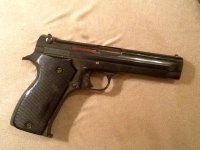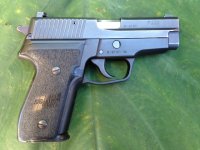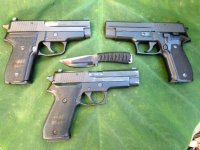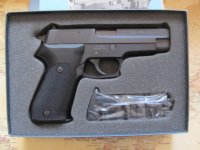Sig firearms are very popular these days. There are a plethora of models to choose from and most of these models are available in multiple color schemes and configurations. The sky is the limit and Sig sells a ton of handguns in the USA annually. They seemingly introduce countless new pistols on a yearly basis.
So where did all this begin? Travel back in time to about 1970 when Schweizerische Industrie Gesellschaft (SIG) of Switzerland was fast advancing their manufacturing processes with new state of the art machinery. This would enable them to develop a new pistol at greatly reduced manufacturing costs. At the time, the extraordinarily accurate, tough, dependable, and super high quality P210 had been the adopted pistol of the Swiss army since replacing the Luger over two decades earlier. The drawback of the P210 was cost. It was very expensive to manufacture, resulting in sagging commercial sales and army orders. Furthermore, its single action design was aging a bit as a military sidearm. Finally, both the Swiss military and police forces all but demanded a lower cost replacement.
The P210 was the only handgun Sig had ever built, but was now faced with a big challenge and needed some help. Sig wanted this new pistol to gain worldwide fanfare. Hampered by the Swiss law prohibiting exportation of firearms, Sig sought to bypass this law by joining forces with a foreign gun firm. J.P.Sauer & Sohn of Germany was just the sort of company Sig was looking to merge with. Sig wanted the new handgun to be of a double action design and configuration. During the early 1970's, double action autos were very quickly rising in popularity and preference over older single action designs. Being that Sig’s only handgun was the P210, they had very little experience with the double action designs. Sauer, on the other hand, had extensive experience with producing double action pistols, such as the 38H. Combining Sig’s new manufacturing technology and Sauer’s experience was a match made in heaven for both of the companies.
Once this great partnership was established, it did not take long before a new pistol was launched in 1974. The following year, it was adopted by the Swiss army and called the Pistole 75 or P75. Commercially the gun was known as the Sig-Sauer P220. The chambering did not change from the P210, which was 9mm Parabellum. This pistol was wildly different from the legendary sidearm it replaced. Gone was the dense and costly forged steel slide and frame of the Sig P210. Instead the P220 had a heavy sheet metal welded stamping for a slide, coupled with a lightweight aluminum alloy frame. This greatly reduced the manufacturing cost while still giving the P220 great reliability, very good accuracy, and acceptable durability.
The design of the P220 is that of the common Browning locked breech. It differed from many before it and since to include the P210, 1911, Browning Hi Power, S&W 39, CZ 75, etc. The difference was that the P220 did not have barrel lugs or matching recesses in the slide to lock the barrel and slide together. Instead it used a large section of the breech end of the barrel to lock into the ejection port. Many pistols have used this system since, to include Glock. The P220 also included a hammer drop on the left side of the frame much like the old Sauer 38H.
This new pistol was very well received in several markets. In the United States, the P220 was imported under the name of Browning BDA until 1980. After that, Sig Sauer was finally able to import it under its own name. All of these early guns had heel mag releases. In addition to 9mm, the early heel release P220 became available in 30 Luger and 38 Super.
To follow up on the P220, Sig Sauer developed a compact version of the gun for the German police in 1978, called the P225. Germany designated this pistol the P6 and adopted it along with the Walther P5 and HK P7. During the 1980‘s, Sig Sauer introduced the double stack P226 and P228 to keep up with popular demand for higher capacity pistols. Once these were in place, the old warhorse P220 more or less became designated for the 45ACP round.
While I already had a 9mm P220 in my collection, I decided to add this one due to its incredible condition and completeness. This 1983 gun is in 97-98% condition and I don’t think it was shot much at all. The second magazine was never even loaded as far as I can tell. The manual looks new and it even includes the original test target from Germany, which was one ragged hole with three shots at 20 meters from a machine rest. The blue cardboard box is outstanding. The finish on these old West German Sigs wasn’t the nicest and they show every handling mark clearly. However, this one is nearly perfect. Its the nicest old P220 I’ve ever seen.
Had it not been the original Sig Sauer in its original caliber, I would not have bought it. Had it been in lesser condition and/or without everything from the factory, I wouldn’t have bought it either. What sold me was that its just a pristine example of the origin of Sig Sauer. Its the original handgun. While its not the icon that the P226 has since become, its still about as classic as 9mm pistols get. I own and love all the old West German Sigs, but the P220 is my favorite by far.
At any rate, who else here owns a West German P220?
Thanks for reading and please enjoy the pics.











So where did all this begin? Travel back in time to about 1970 when Schweizerische Industrie Gesellschaft (SIG) of Switzerland was fast advancing their manufacturing processes with new state of the art machinery. This would enable them to develop a new pistol at greatly reduced manufacturing costs. At the time, the extraordinarily accurate, tough, dependable, and super high quality P210 had been the adopted pistol of the Swiss army since replacing the Luger over two decades earlier. The drawback of the P210 was cost. It was very expensive to manufacture, resulting in sagging commercial sales and army orders. Furthermore, its single action design was aging a bit as a military sidearm. Finally, both the Swiss military and police forces all but demanded a lower cost replacement.
The P210 was the only handgun Sig had ever built, but was now faced with a big challenge and needed some help. Sig wanted this new pistol to gain worldwide fanfare. Hampered by the Swiss law prohibiting exportation of firearms, Sig sought to bypass this law by joining forces with a foreign gun firm. J.P.Sauer & Sohn of Germany was just the sort of company Sig was looking to merge with. Sig wanted the new handgun to be of a double action design and configuration. During the early 1970's, double action autos were very quickly rising in popularity and preference over older single action designs. Being that Sig’s only handgun was the P210, they had very little experience with the double action designs. Sauer, on the other hand, had extensive experience with producing double action pistols, such as the 38H. Combining Sig’s new manufacturing technology and Sauer’s experience was a match made in heaven for both of the companies.
Once this great partnership was established, it did not take long before a new pistol was launched in 1974. The following year, it was adopted by the Swiss army and called the Pistole 75 or P75. Commercially the gun was known as the Sig-Sauer P220. The chambering did not change from the P210, which was 9mm Parabellum. This pistol was wildly different from the legendary sidearm it replaced. Gone was the dense and costly forged steel slide and frame of the Sig P210. Instead the P220 had a heavy sheet metal welded stamping for a slide, coupled with a lightweight aluminum alloy frame. This greatly reduced the manufacturing cost while still giving the P220 great reliability, very good accuracy, and acceptable durability.
The design of the P220 is that of the common Browning locked breech. It differed from many before it and since to include the P210, 1911, Browning Hi Power, S&W 39, CZ 75, etc. The difference was that the P220 did not have barrel lugs or matching recesses in the slide to lock the barrel and slide together. Instead it used a large section of the breech end of the barrel to lock into the ejection port. Many pistols have used this system since, to include Glock. The P220 also included a hammer drop on the left side of the frame much like the old Sauer 38H.
This new pistol was very well received in several markets. In the United States, the P220 was imported under the name of Browning BDA until 1980. After that, Sig Sauer was finally able to import it under its own name. All of these early guns had heel mag releases. In addition to 9mm, the early heel release P220 became available in 30 Luger and 38 Super.
To follow up on the P220, Sig Sauer developed a compact version of the gun for the German police in 1978, called the P225. Germany designated this pistol the P6 and adopted it along with the Walther P5 and HK P7. During the 1980‘s, Sig Sauer introduced the double stack P226 and P228 to keep up with popular demand for higher capacity pistols. Once these were in place, the old warhorse P220 more or less became designated for the 45ACP round.
While I already had a 9mm P220 in my collection, I decided to add this one due to its incredible condition and completeness. This 1983 gun is in 97-98% condition and I don’t think it was shot much at all. The second magazine was never even loaded as far as I can tell. The manual looks new and it even includes the original test target from Germany, which was one ragged hole with three shots at 20 meters from a machine rest. The blue cardboard box is outstanding. The finish on these old West German Sigs wasn’t the nicest and they show every handling mark clearly. However, this one is nearly perfect. Its the nicest old P220 I’ve ever seen.
Had it not been the original Sig Sauer in its original caliber, I would not have bought it. Had it been in lesser condition and/or without everything from the factory, I wouldn’t have bought it either. What sold me was that its just a pristine example of the origin of Sig Sauer. Its the original handgun. While its not the icon that the P226 has since become, its still about as classic as 9mm pistols get. I own and love all the old West German Sigs, but the P220 is my favorite by far.
At any rate, who else here owns a West German P220?
Thanks for reading and please enjoy the pics.











Last edited:









